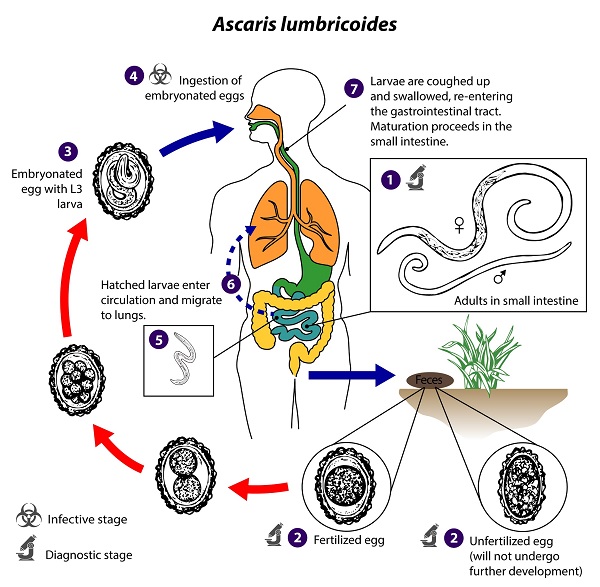Ascaris lumbricoides - Life Cycle, Pathogenesis, Pathology
Life Cycle of Ascaris lumbricoides
Being the only host, the life cycle of Ascaris lumbricoides is completed in a single host i.e. humans. No intermediate host is required to complete its life cycle.
The parasitic infection begins with the ingestion of food, water, or raw vegetables contaminated with the eggs of Ascaris lumbricoides.
these eggs hatch in the small intestine (duodenum) of the host to release the larvae
larvae penetrate the intestinal wall to reach the lymphatic system and venules
via host circulation, the Ascaris lumbricoides reaches the liver where they live for 3 to 4 days
from there they are carried to the right heart and then to the lung
in the lung, the larvae increase in length, and molt twice (on the 5th and on the 10th day) to become fourth-stage larvae (L4)
L4 larvae break out of the pulmonary capillaries to reach the alveoli
from alveoli, the roundworm climbs up the respiratory tract to the pharynx from where they are swallowed back into the small intestine
in the host small intestine, Ascaris lumbricoides undergoes a third molt to become fourth-stage larvae (L5) – which occurs 24 to 28 days after infection
the parasite develops and matures into adults within 6 to 10 weeks of infection
after mating and fertilization, the gravid female Ascaris lumbricoides lays an average of 240,000 eggs per day
these eggs are passed along with the host feces 60 to 75 days after infection
the freshly laid eggs, which contain unsegmented ovum, are not infectious to humans
further development of eggs takes place in most soil where appropriate conditions are met – over 40% humidity and 20-40°C
within 10 to 15 days, first-stage rhabditiform larvae develop in the egg
on the 7th day, while still inside the egg, the parasitic larvae undergo their first molt to give rise to second-stage larvae
the Ascaris lumbricoides eggs containing second-stage larvae are infectious to humans and cause infection if ingested
thus, the life cycle of the parasite continues

Ascaris lumbricoides life-cycle (Source: CDC)
Pathogenesis, Pathology of Ascaris lumbricoides
The pathogenicity of Ascaris lumbricoides is caused by both adult worms and migrating larvae.
Pathonegecity of migrating larvae
The severity of pathological lesions caused by migrating larvae in ascariasis depends on the sensitivity of the host, the nutritional status of the host, and the number of migrating larvae at any specific time.
Individuals who are repeatedly infected by Ascaris lumbricoides are sensitized to the roundworm antigens. Thus the migrating larvae produce an inflammatory and hypersensitive reaction in the lung and liver.
This hypersensitive reaction may cause pathological changes in the host such as granuloma and eosinophilic infiltrates. As a result pneumonitis, Loeffler’s syndrome may occur.
Pathonegecity of adult worm
The pathogenicity caused by adult Ascaris lumbricoides is due to”
Mechanical action
Sporiative action
Allergic reactions
Mechanical action
During the late stage of the parasitic infection, the adult Ascaris lumbricoides can damage the host tissues. In cases of heavy infections, they can obstruct the terminal ileum of the host intestinal tract.
If the adult parasite travels outside of its normal habitat, it can obstruct the appendix, bile duct, pancreatic duct, etc.
Sporiative action
Mostly in case of heavy infections, adult Ascaris lumbricoides affect the nutritional status of the infected host. As the parasite robs the host of the nutrients, the sporiative action leads to malnutrition.
In children with heavy infection, this may lead to obstruction of growth and development.
Allergic reactions
The metabolites released by Ascaris lumbricoides – dead or alive – are toxic and immunogenic to humans. This condition may manifest as fever, urticaria, conjunctivitis, etc.